Abstract
OBJECTIVE: To examine the reporting of cases of occupational cancer in Canada in order to determine reporting requirements, the availability of data, the characteristics of reported cancers and the completeness of reporting. DESIGN: Descriptive epidemiologic study based on data requested from workers' compensation boards (WCBs) and cancer registries in each province and territory from 1980 to 1989. OUTCOME MEASURES: The number of claims accepted and rejected by the WCBs; year of claim, cancer site, sex of claimant, age of claimant at diagnosis, occupation, industry, exposure agent and reasons for rejection of claims; and new primary cancers according to site, age and sex. RESULTS: Reporting of occupational cancer by physicians is required in Alberta, Saskatchewan and Newfoundland. Only British Columbia, Saskatchewan and Ontario were able to provide all the requested information about the claims. Of the 1026 claims in these three provinces almost all were by men, and about two-thirds were for cancers of the respiratory tract. Asbestos was listed as the etiologic agent in more than one-third of the cases. A comparison of the proportion of incident cancers accepted as occupational by the WCBs with the estimated proportion of cancers in the general population attributable to occupation (based on population-attributable risk percentages from epidemiologic data) suggests that less than 10% of occupational cancers [corrected] are compensated. The main source of the deficit is underreporting to WCBs rather than rejection of claims. CONCLUSIONS: The availability of data about occupational cancers in Canada is inconsistent from jurisdiction to jurisdiction, and reporting is incomplete. An active disease surveillance system and additional education of physicians and workers about work-related illnesses may be required to improve reporting.
Full text
PDF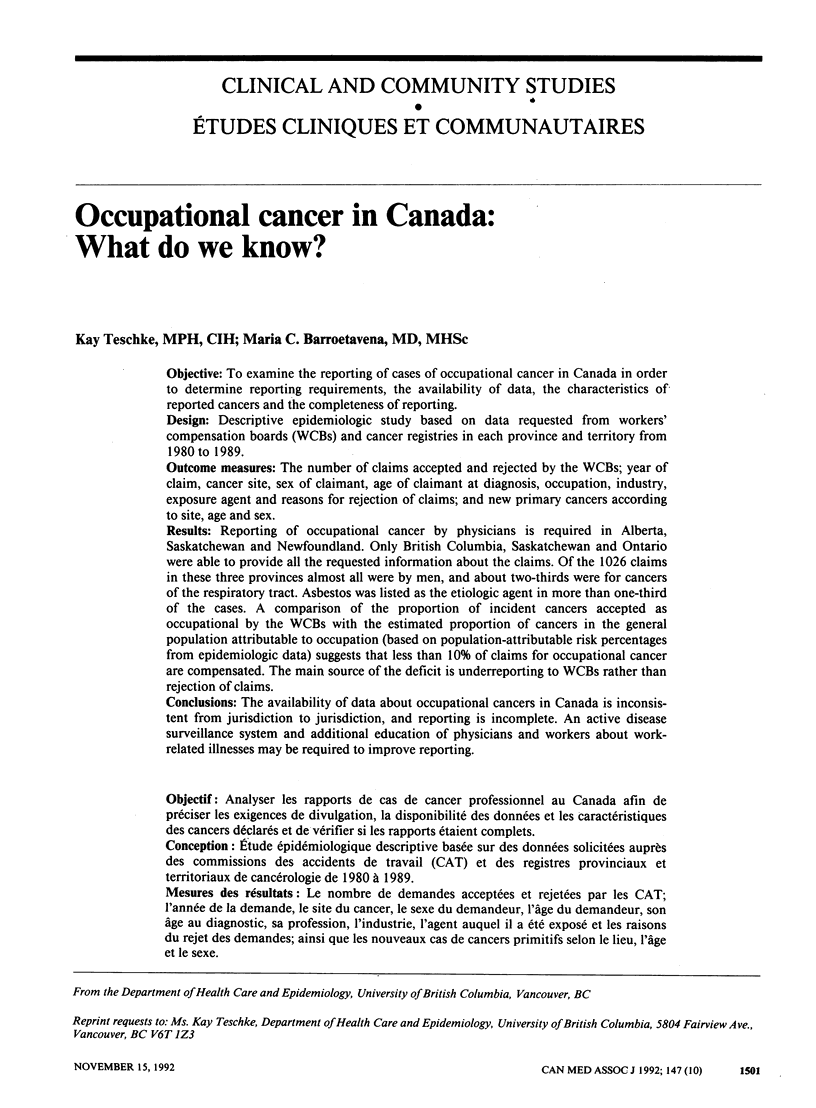
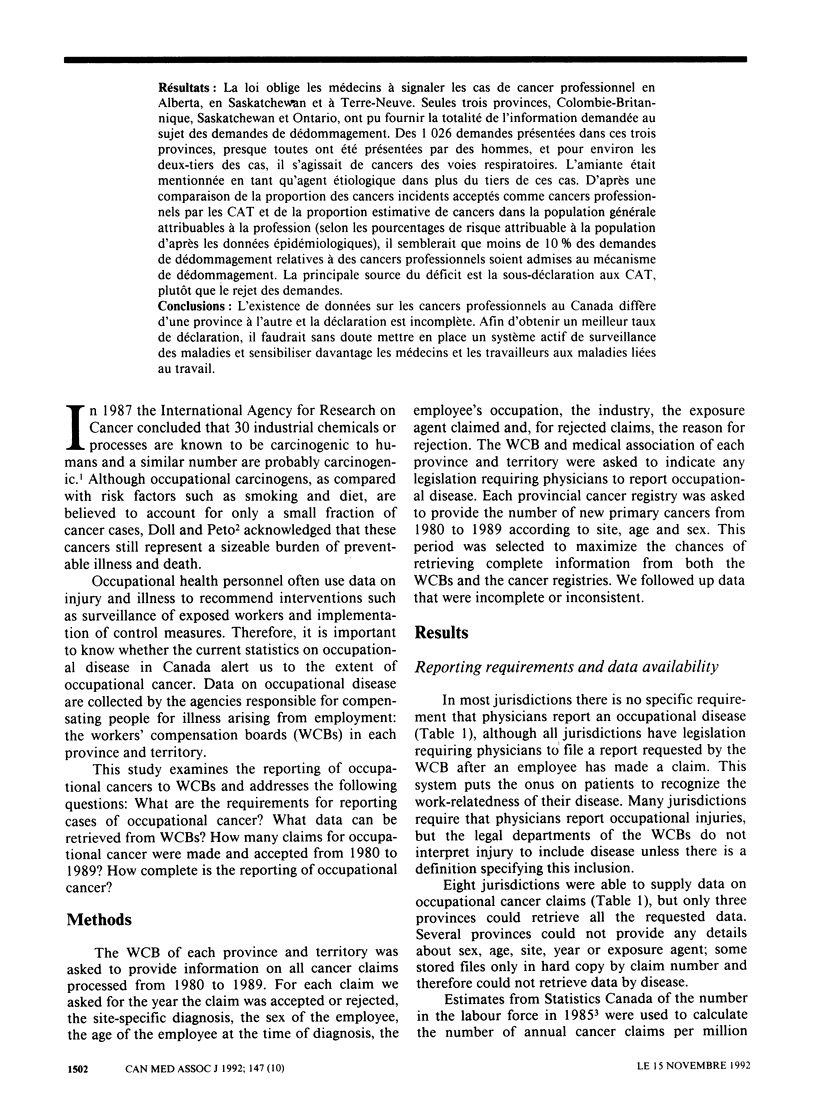
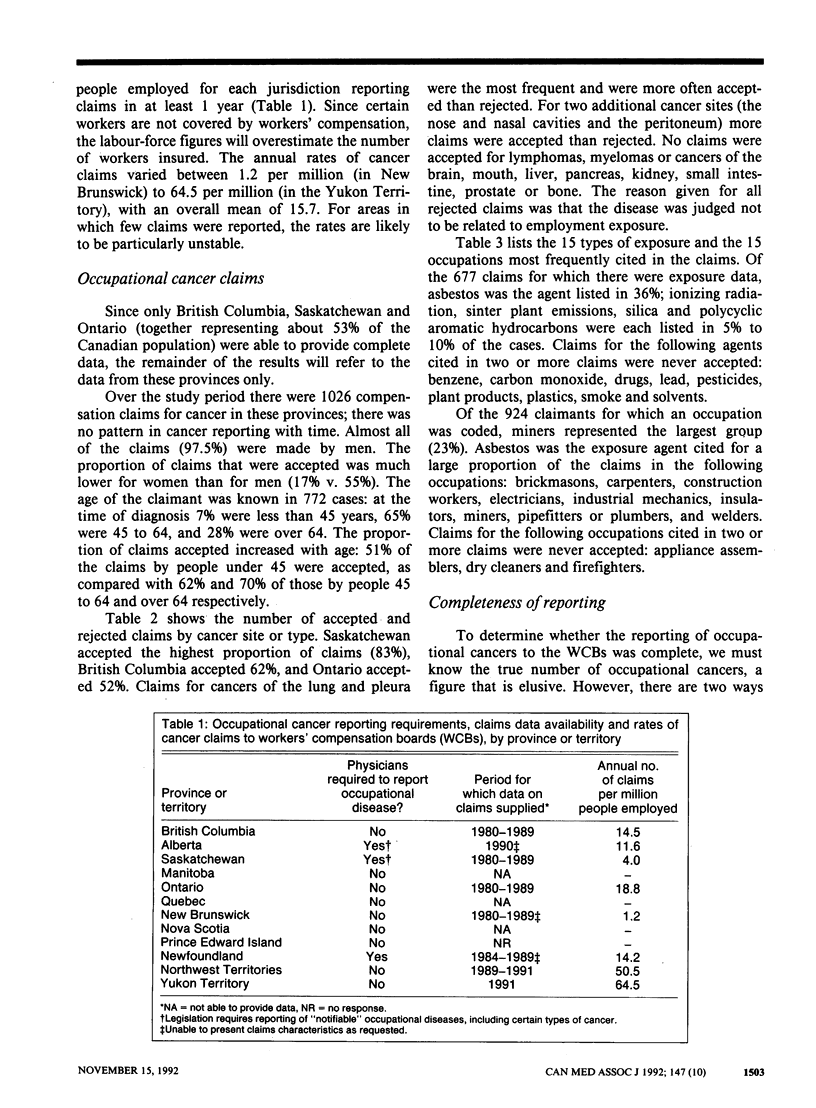
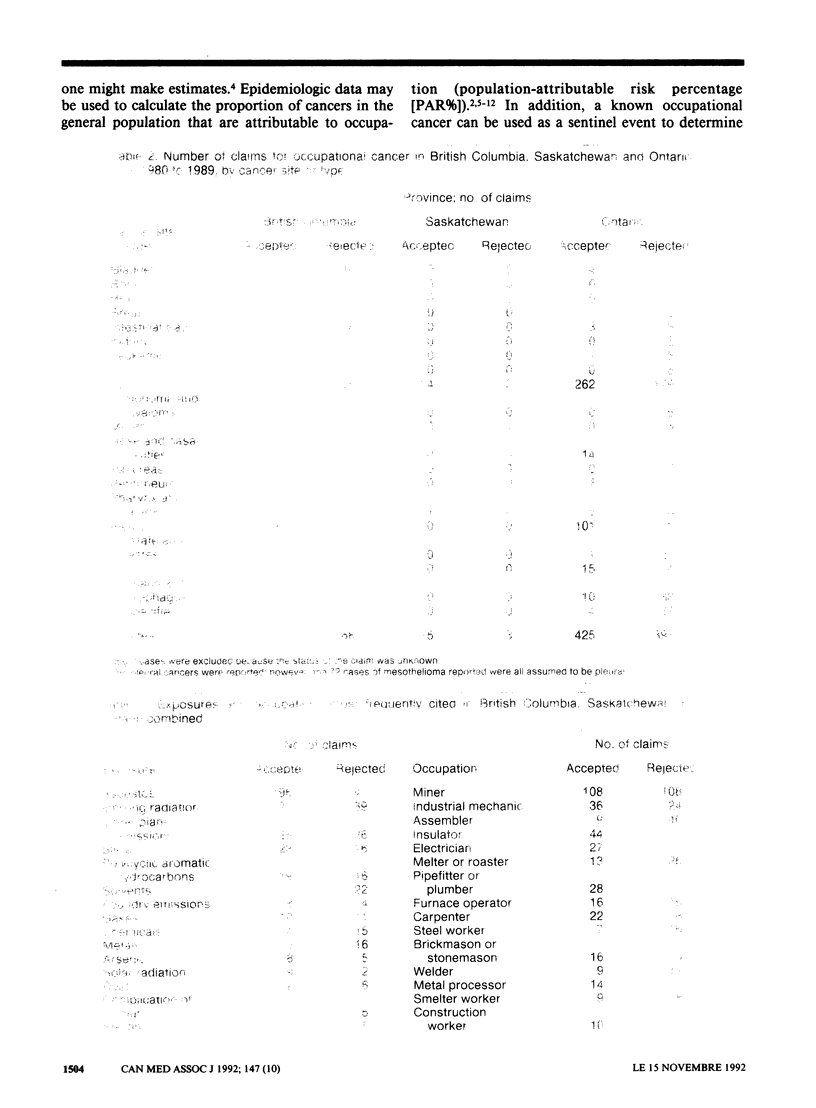
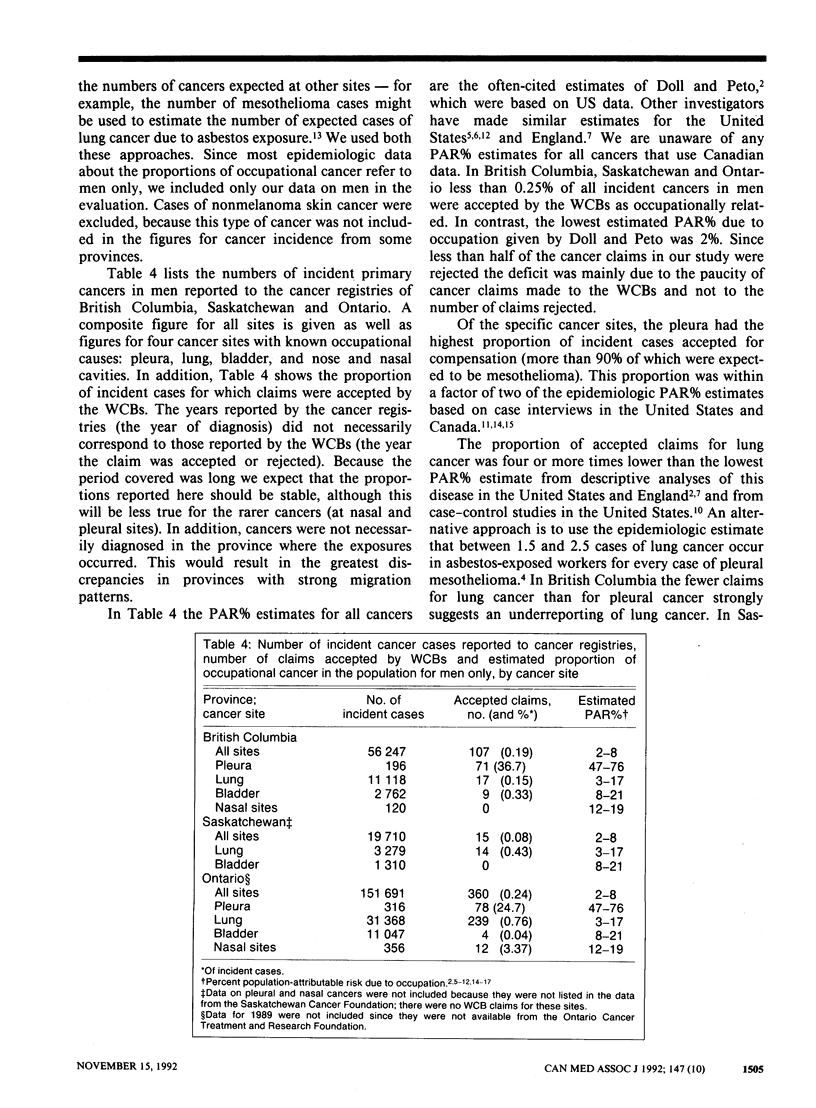
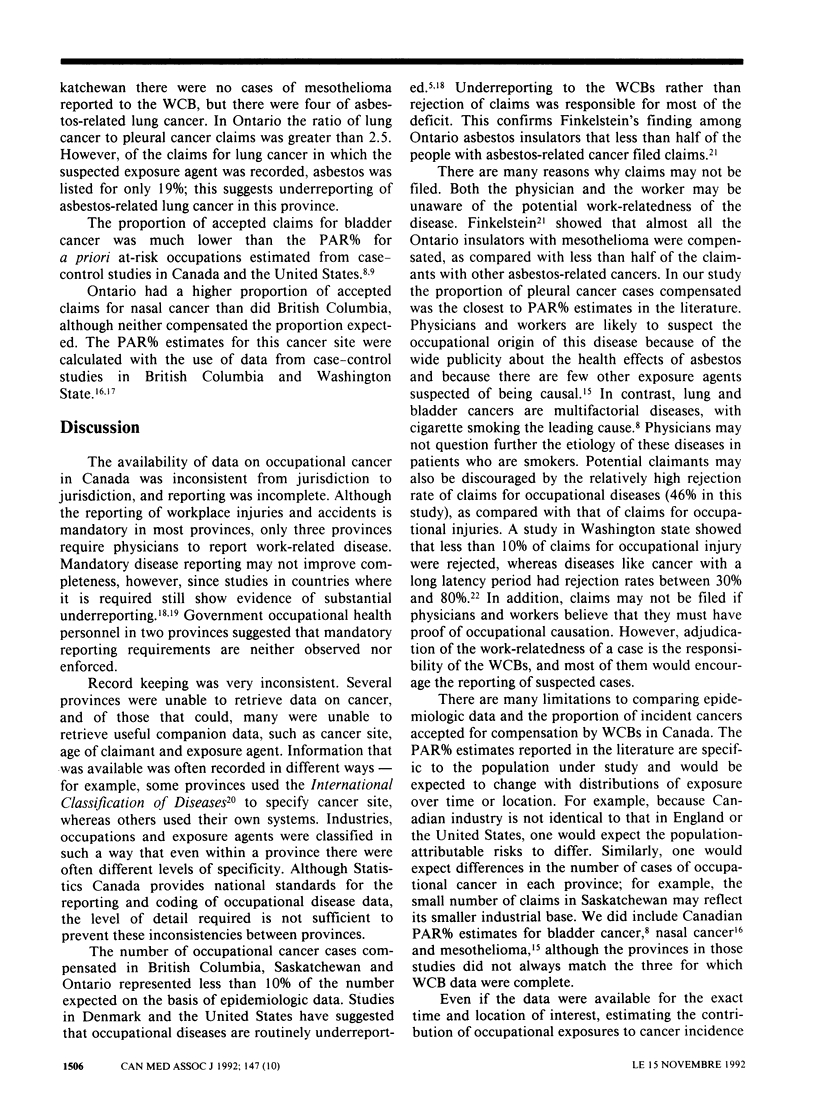
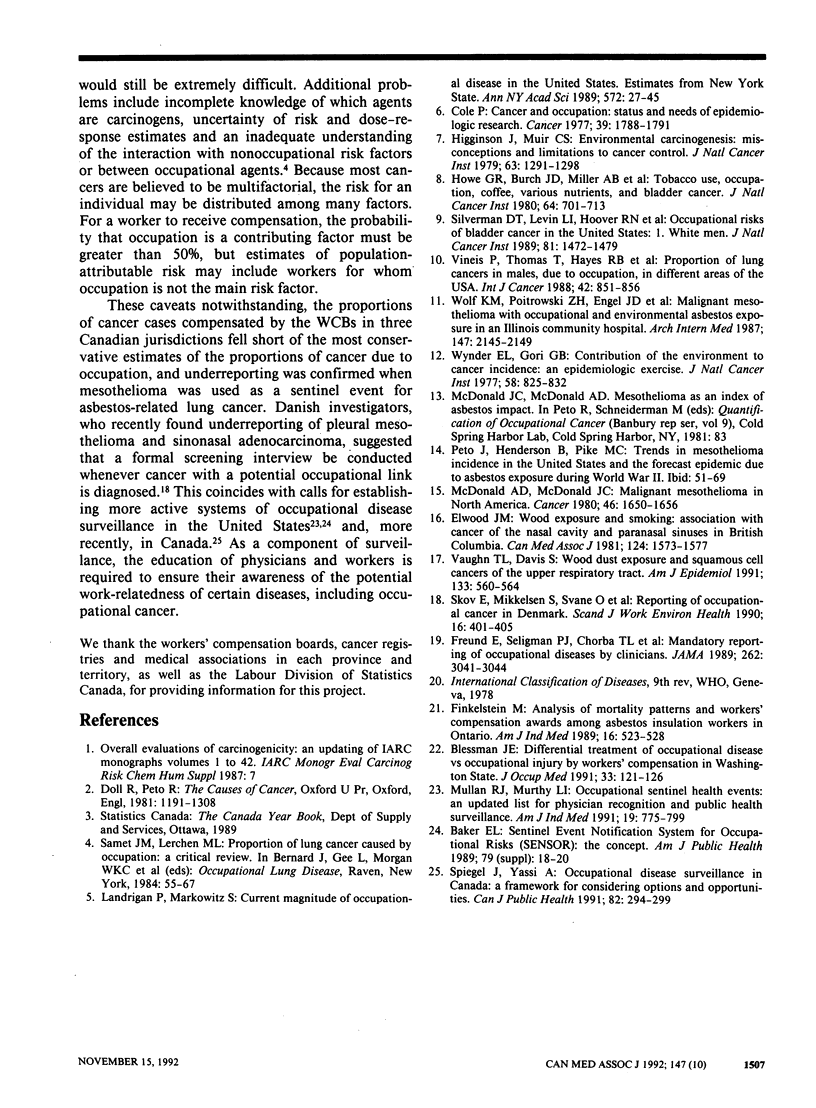
Selected References
These references are in PubMed. This may not be the complete list of references from this article.
- Baker E. L. Sentinel Event Notification System for Occupational Risks (SENSOR): the concept. Am J Public Health. 1989 Dec;79 (Suppl):18–20. doi: 10.2105/ajph.79.suppl.18. [DOI] [PMC free article] [PubMed] [Google Scholar]
- Blessman J. E. Differential treatment of occupational disease v occupational injury by workers' compensation in Washington State. J Occup Med. 1991 Feb;33(2):121–126. [PubMed] [Google Scholar]
- Cole P. Cancer and occupation: status and needs of epidemiologic research. Cancer. 1977 Apr;39(4 Suppl):1788–1791. doi: 10.1002/1097-0142(197704)39:4+<1788::aid-cncr2820390807>3.0.co;2-5. [DOI] [PubMed] [Google Scholar]
- Doll R., Peto R. The causes of cancer: quantitative estimates of avoidable risks of cancer in the United States today. J Natl Cancer Inst. 1981 Jun;66(6):1191–1308. [PubMed] [Google Scholar]
- Elwood J. M. Wood exposure and smoking: association with cancer of the nasal cavity and paranasal sinuses in British Columbia. Can Med Assoc J. 1981 Jun 15;124(12):1573–1577. [PMC free article] [PubMed] [Google Scholar]
- Finkelstein M. M. Analysis of mortality patterns and workers' compensation awards among asbestos insulation workers in Ontario. Am J Ind Med. 1989;16(5):523–528. doi: 10.1002/ajim.4700160505. [DOI] [PubMed] [Google Scholar]
- Freund E., Seligman P. J., Chorba T. L., Safford S. K., Drachman J. G., Hull H. F. Mandatory reporting of occupational diseases by clinicians. JAMA. 1989 Dec 1;262(21):3041–3044. [PubMed] [Google Scholar]
- Higginson J., Muir C. S. Environmental carcinogenesis: misconceptions and limitations to cancer control. J Natl Cancer Inst. 1979 Dec;63(6):1291–1298. [PubMed] [Google Scholar]
- Howe G. R., Burch J. D., Miller A. B., Cook G. M., Esteve J., Morrison B., Gordon P., Chambers L. W., Fodor G., Winsor G. M. Tobacco use, occupation, coffee, various nutrients, and bladder cancer. J Natl Cancer Inst. 1980 Apr;64(4):701–713. [PubMed] [Google Scholar]
- Landrigan P. J., Markowitz S. Current magnitude of occupational disease in the United States. Estimates from New York State. Ann N Y Acad Sci. 1989;572:27–60. doi: 10.1111/j.1749-6632.1989.tb13568.x. [DOI] [PubMed] [Google Scholar]
- McDonald A. D., McDonald J. C. Malignant mesothelioma in North America. Cancer. 1980 Oct 1;46(7):1650–1656. doi: 10.1002/1097-0142(19801001)46:7<1650::aid-cncr2820460726>3.0.co;2-y. [DOI] [PubMed] [Google Scholar]
- Mullan R. J., Murthy L. I. Occupational sentinel health events: an up-dated list for physician recognition and public health surveillance. Am J Ind Med. 1991;19(6):775–799. doi: 10.1002/ajim.4700190610. [DOI] [PubMed] [Google Scholar]
- Silverman D. T., Levin L. I., Hoover R. N., Hartge P. Occupational risks of bladder cancer in the United States: I. White men. J Natl Cancer Inst. 1989 Oct 4;81(19):1472–1480. doi: 10.1093/jnci/81.19.1472. [DOI] [PubMed] [Google Scholar]
- Skov T., Mikkelsen S., Svane O., Lynge E. Reporting of occupational cancer in Denmark. Scand J Work Environ Health. 1990 Dec;16(6):401–405. doi: 10.5271/sjweh.1770. [DOI] [PubMed] [Google Scholar]
- Spiegel J., Yassi A. Occupational disease surveillance in Canada: a framework for considering options and opportunities. Can J Public Health. 1991 Sep-Oct;82(5):294–299. [PubMed] [Google Scholar]
- Vaughan T. L., Davis S. Wood dust exposure and squamous cell cancers of the upper respiratory tract. Am J Epidemiol. 1991 Mar 15;133(6):560–564. doi: 10.1093/oxfordjournals.aje.a115927. [DOI] [PubMed] [Google Scholar]
- Vineis P., Thomas T., Hayes R. B., Blot W. J., Mason T. J., Pickle L. W., Correa P., Fontham E. T., Schoenberg J. Proportion of lung cancers in males, due to occupation, in different areas of the USA. Int J Cancer. 1988 Dec 15;42(6):851–856. doi: 10.1002/ijc.2910420610. [DOI] [PubMed] [Google Scholar]
- Wolf K. M., Piotrowski Z. H., Engel J. D., Bekeris L. G., Palacios E., Fisher K. A. Malignant mesothelioma with occupational and environmental asbestos exposure in an Illinois community hospital. Arch Intern Med. 1987 Dec;147(12):2145–2149. [PubMed] [Google Scholar]
- Wynder E. L., Gori G. B. Contribution of the environment to cancer incidence: an epidemiologic exercise. J Natl Cancer Inst. 1977 Apr;58(4):825–832. doi: 10.1093/jnci/58.4.825. [DOI] [PubMed] [Google Scholar]


